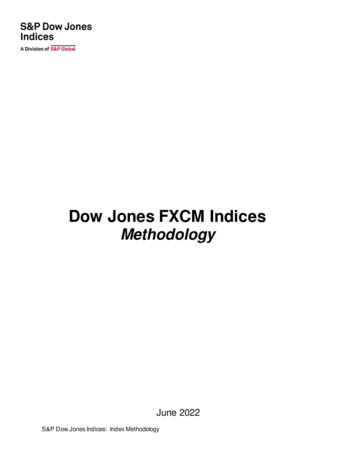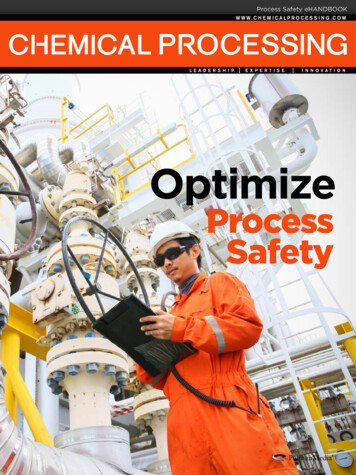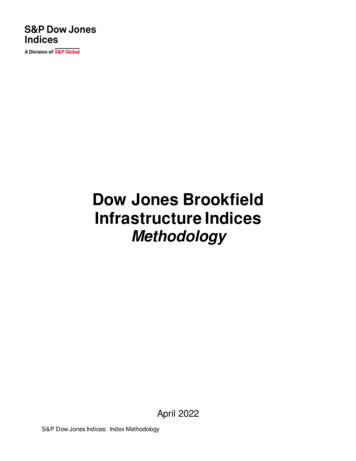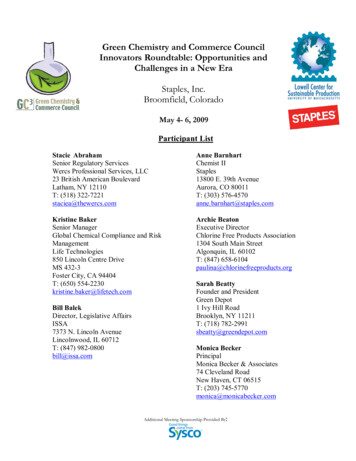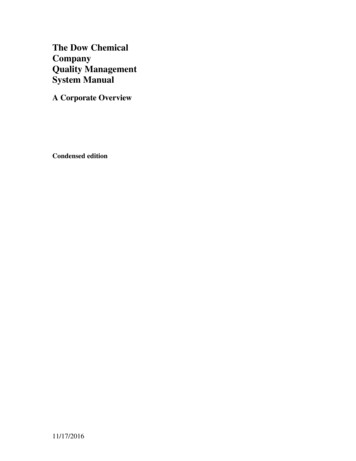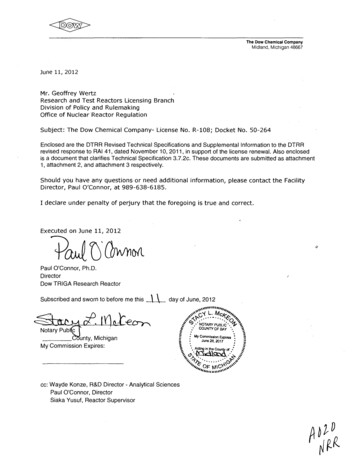
Transcription
The Dow Chemical CompanyMidland, Michigan 48667June 11, 2012Mr. Geoffrey WertzResearch and Test Reactors Licensing BranchDivision of Policy and RulemakingOffice of Nuclear Reactor RegulationSubject: The Dow Chemical Company- License No. R-108; Docket No. 50-264Enclosed are the DTRR Revised Technical Specifications and Supplemental Information to the DTRRrevised response to RAI 41, dated November 10, 2011, in support of the license renewal. Also enclosedis a document that clarifies Technical Specification 3.7.2c. These documents are submitted as attachment1, attachment 2, and attachment 3 respectively.Should you have any questions or need additional information, please contact the FacilityDirector, Paul O'Connor, at 989-638-6185.I declare under penalty of perjury that the foregoing is true and correct.Executed on June 11, 2012Paul O'Connor, Ph.D.DirectorDow TRIGA Research ReactorSubscribed and sworn to before me thisday of June, 2012.,,' r.'(L. Mct. ',,,, : , r. .NOTRPUBL16%.! "' SNotary Publ cSMichin MYCommission Expires .June 28, 2017My Commission Expires:"AIIsoilO icc: Wayde Konze, R&D Director - Analytical SciencesPaul O'Connor, DirectorSiaka Yusuf, Reactor SupervisorCIB 'W:
Attachment IThe DTRR Revised Technical Specifications6/11/2012
Appendix AToFACILITY LICENSE NO. R-108DOCKET NO. 50-264TECHNICAL SPECIFICATIONS AND BASESFORTHE DOW TRIGA RESEARCH REACTORJune/2012
TECHNICAL SPECIFICATIONS AND BASES FOR THE DOWTRIGA RESEARCH REACTOR1. INTRODUCTION1.1ScopeThis document constitutes the Technical Specifications for the Facility License No. 108 asrequired by 10 CFR 50.36 and supersedes all prior Technical Specifications. This documentincludes the "Basis" to support the selection and significance of the specifications. Each basisis included for information purposes only. They are not part of the Technical Specifications,and they do not constitute limitations or requirements to which the licensee must adhere.1.2FormatThese specifications are formatted in conformance to NUREG-1537 and ANSI/ANS15.1-2007guidance.1.3DefinitionsALARA: The ALARA (As Low As Reasonably Achievable) program is a set of procedureswhich is intended to minimize occupational exposures to ionizing radiation and releases ofradioactive materials to the environment.Audit: An audit is a quantitative examination of records, procedures or otherdocuments after implementation from which appropriate recommendations are made.Channel: A channel is a combination of sensors, electronic circuits, and output devicesconnected by the appropriate communications network in order to measure and display thevalue of a parameter.Channel Calibration: A channel calibration is an adjustment of a channel such that itsoutput corresponds with acceptable accuracy to known values of the parameter which thechannel measures. Calibration shall encompass the entire channel, including equipment,actuation, alarm, or trip and shall include a Channel Test.Channel Check: A channel check is a qualitative verification of acceptableperformance by observation of channel behavior. This verification, where possible, shallinclude comparison of the channel with other independent channels or systemsmeasuring the same variable.1
Channel Test: A channel test is the introduction of a signal into the channel forverification that it is operable.Control Rod: A control rod is a device fabricated from neutron absorbing material,which is used to establish neutron flux changes and to compensate for routine reactivitychanges. A control rod may be coupled to its drive unit allowing it to perform a safetyfunction when the coupling is disengaged. Types of control rods shall include:1. Regulating Rod (Reg. Rod): The regulating rod is a control rod having anelectric motor drive and scram capabilities. Its position may be variedmanually or by the servo-controller.2. Shim/Safety Rod: A shim/safety rod is a control rod having an electricmotor drive and scram capabilities.Core Lattice Position: The core lattice position is defined by a particular hole in thetop grid plate of the core. It is specified by a letter indicating the specific ring in the gridplate and a number indicating a particular position within that ring.Excess Reactivity: Excess reactivity is that amount of reactivity that would exist if allcontrol rods were moved to the maximum reactive condition from the point where thereactor is exactly critical (keff 1) at reference core conditions.Experiment: An experiment is any device or material, not normally part of the reactor,which is introduced into the reactor for the purpose of exposure to radiation, or anyoperation which is designed to investigate non-routine reactor characteristics. Specificexperiments shall include:1. Movable Experiment: A movable experiment is one where it is intendedthat the entire experiment may be moved in or near the core or into and outof the core while the reactor is operating.2. Modified Routine Experiment: Modified routine experiments areexperiments which have not been designated as routine experiments orwhich have not been performed previously, but are similar to routineapproved experiments in that the hazards are neither significantly differentfrom nor greater than the hazards of the corresponding routine experiment.3. Routine Experiment: A routine experiment is an approved experimentwhich involves operations under conditions which have been extensivelyexamined in the course of the reactor test programs and which is not defined asany other kind of experiment.2
4. Secured Experiment: A secured experiment is any experiment orcomponent of an experiment that is held in a stationary position relative tothe reactor by mechanical means. The restraining forces must besubstantially greater than those to which the experiment might be subjectedby hydraulic, pneumatic, buoyant, or other forces, which are normal to theoperating environment of the experiment, or by forces which can arise as aresult of credible malfunctions.5. Special Experiment: Special experiments are experiments which areneither routine experiments nor modified routine experiments.6. Unsecured Experiment: An unsecured experiment is any experiment orcomponent of an experiment that does not meet the definition of a securedexperiment.Experimental Facilities: Experimental facilities shall include the rotary specimenrack, sample containers replacing fuel elements or dummy fuel elements in the core,pneumatic transfer systems, the central thimble, and the area surrounding the core.Fuel Element: A fuel element is a single TRIGA fuel element.Irradiation: Irradiation shall mean the insertion of any device or material that is not apart of the existing core or experimental facilities into an experimental facility so thatthe device or material is exposed to radiation available in that experimental facility.Licensed Area: Rooms 51 (51, 51A, 51AA, 51B) and 52 of building 1602.Measured Value: The measured value is the value of a parameter as it appears on theoutput of a channel.Operable: A system or component shall be considered operable when it is capable ofperforming its intended function.Operating: Operating means a component or system is performing its intendedfunction.Operational Core: An operational core shall be a fuel element core, which operateswithin the licensed power level and satisfies all the requirements of the TechnicalSpecifications.Reactivity Worth of an Experiment: The reactivity worth of an experiment is thevalue of the reactivity change that results from the experiment, being inserted into orremoved from its intended position.3
Reactor Operating: The reactor is operating whenever it is not secured or shut down.Reactor Operator (RO): An individual who is licensed to manipulate the controls of areactor.Reactor Safety Systems: Reactor safety systems are those systems, including theirassociated input channels, which are designed to initiate, automatically or manually, areactor scram for the primary purpose of protecting the reactor.Reactor Secured: The reactor is secured when:1. Either there is insufficient moderator available in the reactor to attaincriticality or there is insufficient fissile material in the reactor to attaincriticality under optimum available conditions of moderation and reflection;or,2. All of the following exist:a.The three (3) neutron absorbing control rods are fully inserted asrequired by technical specifications,b. The reactor is shutdown,c. The console key switch is in the "off" position and the key is removedfrom the console,d. No experiments are being moved or serviced that have, on movement,reactivity worth exceeding the maximum value allowed for a singleexperiment, or of one dollar, whichever is smaller, ande.No work is in progress involving core fuel, core structure, installed controlrods, or control rod drives unless they are physically decoupled from thecontrol rods.Reactor Shutdown: The reactor is shut down when it is subcritical by at least onedollar both in the reference core condition and for all allowed ambient conditions, withthe reactivity worth of all installed experiments and irradiation facilities included.Reference Core Condition: The reference core condition is the condition of the corewhen it is at ambient temperature (cold) and the reactivity worth of xenon is negligible( 0.30).Review: A review is a qualitative examination of records, procedures or otherdocuments prior to implementation from which appropriate recommendations aremade.4
Safety Channel: A safety channel is a measuring channel in the reactor safety system.Scram Time: Scram time is the elapsed time from the initiation of a scram signal tothe time the slowest scrammable control rod is fully inserted.Senior Reactor Operator (SRO): An individual who is licensed to direct the activitiesof ROs. Such an individual is also an RO.Should, Shall, and May: The word "shall" is used to denote a requirement; the word"should" is used to denote a recommendation; and the word "may" to denotepermission, neither a requirement nor a recommendation.Shutdown Margin: Shutdown margin shall mean the minimum shutdown reactivitynecessary to provide confidence that the reactor can be made subcritical by means ofthe control and safety systems and will remain subcritical without further operatoraction, starting from any permissible operating condition with the most reactive rod inits most reactive position.Surveillance Intervals: Allowable surveillance intervals shall not exceed thefollowing:1.2.3.4.5.6.7.Quinquennial - interval not to exceed 70 monthsBiennial - interval not to exceed 30 monthsAnnual - interval not to exceed 15 monthsSemiannual - interval not to exceed 7.5 monthsQuarterly - interval not to exceed 4 monthsMonthly - interval not to exceed 6 weeksWeekly - interval not to exceed 10 daysUnscheduled Shutdown: An unscheduled shutdown is any unplanned shutdown of thereactor caused by actuation of the reactor safety system, operator error, equipmentmalfunction, or manual shutdown in response to conditions that could adversely affect safeoperation, not including shutdowns that occur during testing or checkout operations.5
2. SAFETY LIMIT AND LIMITING SAFETY SYSTEM SETTINGS2.1Safety Limit - Fuel Element TemperatureApplicabilityThis specification applies to the temperature of the reactor fuel.ObiectiveThe objective of this specification is to define the maximum fuel temperature that can bepermitted with confidence that a fuel cladding failure will not occur.SpecificationThe temperature in any fuel element in the Dow TRIGA Research Reactor shall not exceed500 C under any condition of operation.BasisThe important parameter for a TRIGA reactor is the fuel element temperature. If thefuel temperature exceeds the safety limit, a loss in the integrity of the fuel elementcladding could arise from a buildup of excessive pressure between the fuel moderatorand the cladding. Since the pressure is caused by the presence of air, fission productgases, and hydrogen from the disassociation of fuel moderator, the magnitude of thispressure is determined by the fuel-moderator temperature and the ratio of hydrogen tozirconium ratio in the alloy.According to several reports on Training Reactor and Isotope Production, GeneralAtomics (TRIGA)-type fuels (NUREG-1282; Simnad et al., 1976 and 1981; Simnad and West etal., 1986; West et al., 1986), for stainless steel-clad UZrH 1.65 LEU 8.5 w% TRIGA fuel, GA hasshown and U.S. Nuclear Regulatory Commission (U.S. NRC) has accepted that the integrity ofthe fuel is not compromised if the peak fuel temperature is less than 1150 TC. For aluminumclad UZrH 1.0 LEU 8 w% TRIGA fuel, the U.S. NRC has accepted that the peak fuel temperatureshould not exceed 500 C (NUREG 1537, Appendix 14.1).6
2.2Limiting Safety System SettingsApplicabilityThis specification applies to the reactor scram setting which prevents the reactor fueltemperature from reaching the safety limit.ObjectiveThe objective of this specification is to prevent the safety limit from being reached.SpecificationThe LSSS shall not exceed 300 kW as measured by the calibrated power channels.BasisAnalysis of the Dow TRIGA Research Reactor (DTRR) at 300 kW resulted in a maximumfuel temperature of less than 350 C following a loss of coolant after infinite hours ofoperation. Therefore setting the LSSS not to exceed 300 kW provides assurance that thesafety limit of 500 'C will not be exceeded (SAR, as supplemented by letter dated December6, 2011).7
3. LIMITING CONDITIONS FOR OPERATON (LCO)3.1Reactivity LimitsApplicabilityThese specifications shall apply to the reactor at all times that it is in operation.ObjectiveThe purpose of the specification is to ensure that the reactor can be controlled and shutdown at all times.Specifications1. The shutdown margin provided by the control rods shall be more than 0.50 with:a.Irradiation facilities and experiments in place and the total worth of all nonsecured experiments in their most reactive state;b. The most reactive control rod fully withdrawn; andc.The reactor in the reference core condition.2. The excess reactivity measured at less than 10 watts in the reference core condition, withexperiments in their most reactive state, shall not be greater than 3.00.3.Positive reactivity insertion rate by control rod motion shall not exceed .20 per second.4. There shall be a minimum of three operable control rods in the reactor core. A controlrod is considered operable when:a.There is no damage to the control rod or drive assembly; andb. The scram time meets the requirement in Technical Specification 3.3,specification c.BasesThe value of the minimum shutdown margin assures that the reactor can be safely shutdown with the most reactive control rod withdrawn. Assigning specifications to themaximum excess reactivity and maximum reactivity insertion rates, serve as additionalrestrictions on the shutdown margin and limits the maximum power excursion that could8
take place in the event of failure of all of the power level safety circuits and administrativecontrols. The requirement for three operable control rods ensures that the reactor can meetthe shutdown specifications (SAR, as supplemented, by letter dated December 6, 2011).3.2Reactor Fuel Parameters LimitsApplicabilityThis specification applies to all fuel elements.ObiectiveThe objective of this specification is to maintain integrity of the fuel elements.SpecificationThe reactor shall not operate with damaged fuel elements, except for the purpose of locatingdamaged fuel elements. A fuel element shall be considered damaged and must be removedfrom the core if:a.The transverse bend exceeds 0.0625 inches (0.159 cm) for stainless steel-cladUZrH 1.65 and 0.125 inches (0.318 cm) for aluminum-clad UZrH 1.oover the length ofthe cladding;b. Elongation exceeds 0.125 inches (0.318 cm) for stainless steel-clad UZrH1 .65 and 0.5inches (1.27 cm) for aluminum-clad UZrH1.o;c.A clad defect exists as indicated by release of fission products; ord. U-235 Burn-up exceeds 50% initial concentration.BasesGross failure or obvious visual deterioration of the fuel is sufficient to warrant declarationof the fuel as damaged. The elongation, bend, and burn-up limits are values that have beenfound acceptable to the U.S. NRC (NUREG-1537).9
3.3Reactor Control Rods and Safety Systems and InterlocksApplicabilityThese specifications apply to the reactor control rods, safety system channels and interlocks.ObiectiveThe objective is to specify the minimum number of reactor control rods, the safety systemchannels and interlocks that shall be available to the operator to assure safe operation of thereactor.SpecificationThe reactor shall not be operated unless:a. The safety channels and the interlocks listed in Table 3.3A are operable;b. The measuring channels listed in Table 3.3B are operable; andc.Each of the three control rods shall scram from the fully withdrawn position to thefully inserted position in a time not to exceed one second.10
TABLE 3.3A SpecificationsMinimum Reactor Safety Channels, Interlocks, and Set PointsMinimumOperableScram Set Point or Interlocks2Not to exceed licensed power level(300kW)Detector High Voltage(NPP1000)1Loss of the High VoltageDetector High Voltage1Loss of the High VoltageManual Console Scram1Push ButtonWatchdog (DAC to CSC)Communication Conflict1Not more than 10 sec delayPrevents control rod withdrawalStartup Count Rate (Interlock)1Rod Drive Control (Interlock)1when the neutron count rate is lessthan 2 cpsPrevents simultaneous manualwi thdrawa l tw o co ntr lwithdrawal of two control rodsScram Channels or InterlocksReactor Power Level (NM1000& NPP1000)'(NM1000)Prevents control rod withdrawalReactor Period (Interlock)1when the period is less than 3secondsNote: Bypassing of channels and interlocks in this table is not permitted.1 Any single power level channel may be inoperable while the reactor is operating forthe purpose of performing a channel check, channel test, or channel calibration.11
TABLE 3.3B SpecificationsMeasuring Channel 2Minimum Number OperableNM10001NPP10001Reactor Pool Water RadioactivityMonitorReactor Pool Water TemperatureMonitor1Reactor Pool Water Level112 ifany required measuring channel becomes inoperable while the reactor is operating,for reasons other than identified in this TS, the channel shall be restored to operationwithin 5 minutes or the reactor shall be immediately shutdown.BasesNUREG-1537 recommends at least two independent power level scram channels thatprovide diversity. This is accomplished by having one power level scram channel as ananalog channel. The control rod scram time specification on the three control rods assuresthat the reactor can be shutdown promptly when a scram signal is initiated and that thereactor can meet the shutdown specifications (SAR, as supplemented, by letter datedDecember 6, 2011).Uses of the specified reactor safety channels, set points, and interlocks given in table3.3A assure protection against operation of the reactor outside the safety limit. Therequirements for the specified measurement channels in table 3.3B provide assurance thatimportant reactor operation parameters (power level, water radioactivity, watertemperature, and water level) can be monitored during operation. The specification ofmaximum positive reactivity insertion rate helps assure that the Safety Limit is not exceeded(Dow SAR, as supplemented by U.S. NRC letter dated December 6, 2011).For footnote 1, taking a single measuring channel off-line for a short duration for thepurpose of a channel check, test or calibration is considered acceptable because in somecases, the reactor must be operating in order to perform the channel check, calibration ortest. The redundant power level channel provides the scram function for the short periodthat the other power level channel is out of service. For footnote 2, events which lead tothese circumstances are self-revealing to the operator.12
3.4Reactor Coolant SystemsApplicabilityThese specifications apply to the quality of the coolant in contact with the fuel cladding, tothe level of the coolant in the pool, and to the bulk temperature of the coolant.ObiectivesThe objectives of this specification include minimization of corrosion of the cladding of thefuel elements and neutron activation of dissolved materials, detection of releases ofradioactive materials into the coolant before such releases become significant, ensuring thepresence of an adequate quantity of cooling and shielding water in the pool, and preventionof the thermal degradation of the ion exchange resin in the purification system.Specifications1.The conductivity of the pool water shall not exceed 5 Iimho/cm averaged over onemonth.2. The pool water pH shall be in the range of 5.0 to 7.5.3. The radioactivity of the reactor pool water shall not exceed the limits of 10 CFR 20Appendix B Table 3 for radioisotopes with half-lives 24 hours.4. The water shall cover the core of the reactor to a minimum of 15 feet above the coreduring operation of the reactor.5. The bulk temperature of the coolant shall not exceed 60 C during operation of thereactor.6. There shall be an audible alarm on the coolant level set at 15 ft 10 in above the core.BasesIncreased levels of conductivity in aqueous systems indicate the presence of corrosionproducts and promote more corrosion. Experience with water quality control at manyreactor facilities, including operation of the Dow TRIGA Research Reactor since 1967, hasshown that maintenance within the specified limit provides acceptable corrosion control.Maintaining low levels of dissolved electrolytes in the pool water also reduces theamount of induced radioactivity. Low levels of dissolved electrolytes in the pool waterdecrease the exposure of personnel to ionizing radiation during operation and maintenance.The pool water conductivity is monitored continually, except during maintenance.13
Monitoring the pH of the pool water provides early detection of extreme values of pHwhich could enhance corrosion. Limiting the radioactivity to this level will help ensure thatany disposal of pool water, either planned or inadvertent, will be within the limits of 10 CFR20. This specification also provides verification of absence of fission product leakage.Maintaining the specified depth of water in the pool provides shielding of the radioactivecore which reduces the exposure of personnel to ionizing radiation in accordance with theALARA program. This specification also maintains the height of water above the core used inthermal-hydraulic analyses (SAR, as supplemented by letter dated December 6, 2011).Maintaining the bulk temperature of the coolant below the specified limit assuresminimal thermal degradation of the ion exchange resin. This specification is consistent withthe thermal-hydraulic analyses (SAR, as supplemented by letter dated December 6, 2011).The alarm is audible in the control room as well as outside of the control room, and italerts operating staff and other people in the building, when the coolant water level is low, totake appropriate action.14
3.5VentilationApplicabilityThis specification applies to the reactor room ventilation.ObiectiveThe objective of this specification is to mitigate the consequences of possible release ofradioactive materials to unrestricted areas.SpecificationThe ventilation system shall be operating whenever the reactor is operated, fuel ismanipulated, or radioactive materials with the potential of airborne releases are handled inthe reactor room. The ventilation system is considered operable if:a.The exhaust and the inlet fans are operating;b. The external door (Door 10) is closed; andc.The exhaust louvers are open.BasisThis specification ensures that the ventilation is operating and configured to control anyreleases of radioactive material during fuel handling, reactor operation, or the handling ofpossible airborne radioactive material in the reactor room.15
3.6Radiation Monitoring Systems and Effluents3.6.1 Radiation Monitoring SystemsApplicabilityThese specifications apply to the radiation monitoring systems.ObiectiveThe objective isto specify the minimum radiation monitoring channels that shall be availableto the operator to assure safe operation of the reactor.SpecificationThe reactor shall not be operated unless the minimum number of each radiation monitoringchannel, listed in Table 3.6, are operating.Table 3.6Radiation Measuring ChannelsNumberContinuous Air Monitor (CAM)1Area Radiation Monitor (ARM)'1Environmental Monitor (Film badges)41Whenthe area radiation monitor channel becomes inoperable, operations may continueonly if a portable gamma-sensitive ion chamber is utilized as a temporary substitute,provided that the substitute can be observed by the reactor operator, can be installed withinI hour of discovery, and not to exceed 60 days.BasesThe CAM provides information of existing levels of radiation and air-borne radioactivematerials, including particulate alpha or beta emitters, which could endanger operatingpersonnel or which could warn of possible malfunctions of the reactor or the experiments inthe reactor.16
The ARM provides information of existing levels of radiation and airborne radioactivematerials which could endanger operating personnel or which could warn of possiblemalfunctions of the reactor or the experiments in the reactor.The film badges or any other environmental monitors, placed in the reactor roomprovide historical records of radiation exposures in the reactor room. One of the four filmbadges is placed in the control room. Experience at the DTRR showed that the 4 film badgesare adequate for monitoring environmental radiation exposures.For footnote 1, an analysis has shown that it takes more than 60 minutes for theradiation level in the reactor room to exceed the alarm set level of 2mR/hr (SAR, assupplemented by letter dated January 20, 2012, RAI No. 56). Therefore substituting anobservable ion chamber within 1 hr assures that the reactor operator has the tool to observeactionable radiation level in the reactor room.3.6.2 EffluentsApplicabilityThis specification applies to the release rate of 4 1Ar.ObiectiveThe objective is to ensure that the concentration of 41Ar in the unrestricted areas shall bebelow the applicable effluent concentration value in 10 CFR 20.SpecificationThe annual average concentration of 41Ar discharged into the unrestricted area shall notexceed 1 x10-9 ýiCi/ml.BasesOperational experience at DTRR shows that the use of the Rabbit System, an irradiationfacility, is the main contributor to the release of 4 1Ar. An analysis has shown that continuousoperation of the Rabbit System will result in an annual release of 7.94x10-12 ýtCi/ml, with acorresponding annual TEDE to a member of the public in an unrestricted area of 0.056mR/yr. (SAR, as supplemented by letter dated June 11, 2012, an additional information toRAI No. 41). The TS value of I x10-9 tCi/ml, which corresponds to a dose of 7.1 mR/yr at thenearest unrestricted area release point, is 30% lower than the 10 CFR 20 Appendix B effluentconcentration value, and is therefore sufficient to meet the objective of this specification.The amount of 41Ar effluent discharged, every year, will be calculated based on the actualnumber of hours the Rabbit System was operated and the result will be provided in theannual report.17
3.7Experiments3.7.1 Reactivity and Position LimitsApplicabilityThese specifications apply to experiments installed in the reactor and the irradiation facilities.ObiectiveThe objective of these specifications is to prevent damage to the reactor or excessive releaseof radioactive materials in case of failure of an experiment.SpecificationThe reactor shall not be operated unless the following conditions governing experimentsexist:a.The sum of the total absolute value of reactivity worths of all experiments shall notexceed 1.00;b. Experiments having reactivity worths of greater than 0.75 shall be securely locatedor fastened to prevent inadvertent movement during reactor operation; andc.Experiments shall not occupy adjacent fuel element positions in the B- and C-ringsfuel locations.BasesThese specifications are intended to limit the reactivity of the system so that the safetylimit would not be exceeded even ifthe experiment were in the B-ring or C-ring, or if thecontribution to the total reactivity by the experiment reactivity should be suddenly moved.The reactivity worth limit of 1.00 for all experiments is intended to prevent the reactorfrom becoming prompt critical during experiments.The reactivity limit of 0.75 for movable experiments is designed to prevent aninadvertent reactor pulse from occurring and maintain a reactivity value below the shutdownmargin. The specification for the unsecured experiment ( 0.75) is consistent with thereactivity insertion behavior analyses (SAR, as supplemented by letter dated December 6,2011).The prevention of experiments from occupying adjacent fuel locations in the B and Crings helps to limit the power excursions that may arise due to experiments and to be able tocontrol the reactor within the limits imposed by the license.18
3.7.2 MaterialsApplicabilityThese specifications apply to experiments installed in the reactor and the irradiation facilities.ObiectiveThe objective of these specifications is to prevent damage to the reactor or excessive releaseof radioactive materials in case of failure of an experiment.SpecificationThe reactor shall not be operated unless the following conditions governing experimentsexist:a.Experiments containing materials corrosive to reactor components, compoundshighly reactive with water, potentially explosive materials or liquid fissionablematerials shall be doubly encapsulated;b. Materials which could react in a way which could damage the components of thereactor (such as gunpowder, dynamite, TNT, nitroglycerin, or PETN) shall not be
Enclosed are the DTRR Revised Technical Specifications and Supplemental Information to the DTRR revised response to RAI 41, dated November 10, 2011, in support of the license renewal. Also enclosed is a document that clarifies Technical Specification 3.7.2c. These documents are submitted as attachment


